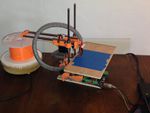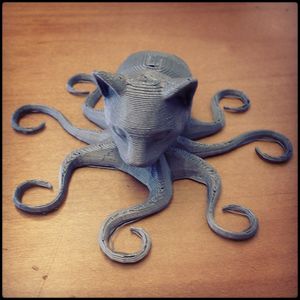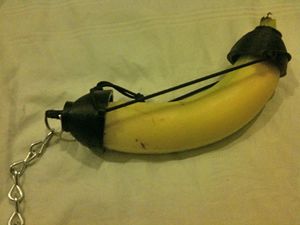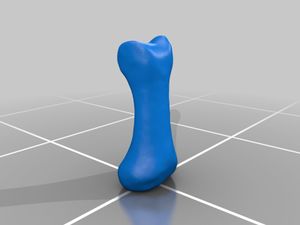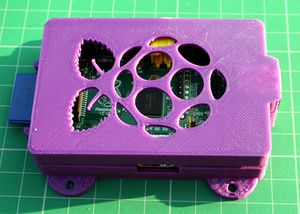User:Dgdwazzaaa
Contents
- 1 Blog Fifteen 12/03/13
- 2 Blog Fourteen 12/02/13
- 3 Blog Thirteen 12/01/13
- 4 Blog Twelve 12/01/13
- 5 Blog Eleven 11/30/13
- 6 Blog Ten 10/31/13
- 7 Blog Nine 10/31/13
- 8 Blog Eight 10/30/13
- 9 Blog Seven 10/29/13
- 10 Blog Six 10/08/13
- 11 Blog Five 10/07/13
- 12 Blog Four 09/25/13
- 13 Blog Three 09/16/13
- 14 Blog Two 09/11/13
- 15 Blog One 09/04/13
- 16 Introduction
Blog Fifteen 12/03/13
Odd Prints
In this article I was introduced to two things I never though could or needed printing.
One of the the Number 5 on the list: Houses . Having cranes, which is what a 3D printer does in a abstract way, in building construction is a common occurrence, but I believe concrete needs steel in order to be strong enough to support intricate constructions. Steal would be hard to extrude, so simply for straight walls, or large domes, I propose a Brick-laying robot to do the job.
Number 8 on the list Sex Toys also seems like a not so good idea. I think that cheap RepRap printers often create thin threads of plastic that can sometime unspool into sharp edges and could potentially be very uncomfortable. However, high end 3D printers would not have that problem.
Blog Fourteen 12/02/13
Future 3D Printer Designs
I really like the Printrbot Simple both for its price and small design. It will most likely be the first printer I buy before I start replicating my own. Here are some good options that I might replicate.
The only issue I see is that the plastic has to travel quite a while until it reaches the actual extruder, so this might lead to problems. For example, due to constant forward and backward motion the plastic might bend and not execute the commands exactly. Furthermore, tension in the plastic string might arise when the extruder head reaches its maximum printing points. Other issues may be if the extruder control part is not calibrated well and due to the nature of printed parts that could be difficult.
Blog Thirteen 12/01/13
Printing Conductive Materials
Circuit Scribe is a Kickstarter project that features a ballpoint pen that writes in conductive ink.
Having 3D printers print conductive material, like this ink, would allow for much greater versatility of everyday objects to be created. I could be possible to have the printer print the "shell and wiring" of the object and then just manually add the more intricate electronic components. Having all of the advantages of 3D printing we could make all the plastic shells of the components in the house. Attach an electric cable and the device will run.
The electronic ink could be added to the one of the extruders of dual-extruder printer.
Blog Twelve 12/01/13
Open source design platforms I have very little working knowledge in 3D modeling programs such as Maya or Solidworks. However, since I have programming background, the OpenSCAD software makes me thrilled. Editing the 3D model is made by using 3 shapes, 4 transformations and 3 CSG Operations (here is a tutorial explaining them in detail ) to create much more complicated shapes that have several benefits. Firstly, there would be no accidental holes in the model. However, what excites me most is that models can be made using an algorithm. That gives it big amounts of versatility in creating patterns(like this phone case), some fractal geometries or some other magical things, like growing geometries.
One drawback that I can think of is that it will be difficult to create detailed models as the ones used in game development. That being said I installed the program and was very happy with its simple interface. Will definitely explore it more. In the meantime here is a gallery of models created by OpenSCAD
Blog Eleven 11/30/13
Working with printers on daily basses
After working with the 3D Printers in 201 Hammond for almost an entire semester two problems are an often occurrence. Filament stops extruding mid-print and bed not properly leveled. The first issue I have fixed by adjusting(often tightening) the bolts in the extruder head assembly. The second, besides the obvious bed nuts adjustment, the issue could be in difference of height in the X axis holders.
Furthermore, an annoying issue are the little bits of plastic that lie all around the printers. This suggest that most people do not clean up after themselves. Some incentives might be enforced to deal with the issue.
Blog Ten 10/31/13
Jeff Immelt is the ninth chairman of GE. During an interview with ForaTv he discusses some of the benefits in 3D manufacturing. One of them is the minimal amount of waste(compared to current subtractive way of manufacturing) generated when the part is printed on the spot. Creating engine parts would be more efficient and in less costly way. In addition, parts would be more customizable and designed faster. Jeff Immelt believes 3D Printing “is going to be a great place to put capital.”
Terry Tai-Ming Guo is the CEO of Hon Hai Precision, also known as Foxconn. According to Forbes magazine, the company is the world's largest electronics contract manufacturer. He famously said that "3D printing is a gimmick.". Elaborating that 3D printing is not suitable for mass production, not able to print leather and currently does not have any commercial value. Hon Hai Precision mass produces most of its electronic products. For such process, it is much cheaper than and much more precise than current 3D Printing technology.
Blog Nine 10/31/13
Discussion of How To 3D Print Your Own Coffee Grinder article
Everything good about this is the same as any appliance that would be printed in a 3D printer. It is cheap, recyclable, easy to modify and repair. Most appliances around the house have a plastic shell, which covers the inner-workings, so it is a perfectly logical solution for anyone to customize their own objects' covers.
An issue with the coffee grinder is that plastics and food should not be mixed. A problem with this could be that pieces of plastic can break, due to the fast spinning motor needed for grinding, and end up in the coffee which when brewed can melt the plastic and release some pollutants in the drink. Maybe one day there would be a food grade/edible plastic that could be sturdy enough to do the job.
Discussion of OS WaterBoiler
The major difference between making one Water Boiler or producing many is the compliance with regulations and making sure it fits well with what other people might use it for. I believe the article is well elaborated.
Blog Eight 10/30/13
Four different tasks
Part 0) Part of this blog has been inspired by the Virginia Tech's : Design, Research, and Education for Additive Manufacturing Systems Lab and its awesome DREAMS acronym and the not so awesome abbreviation of the : The National Additive Manufacturing Innovation Institute or NAMII
Part A) All of the last four of the : AMRI projects: "3D Printing via laser-sintering of thermoplastic powders" , "Ink-jet printing of genetically modified living bacteria", "Digital light projection (DLP) photolithography of plastics and hydrogels" and "Bacterial cellstruder for synthetic biology studies, seem to be above the level of the parts made available to us in our EDSGN 497J class. However, the one that was best presented, and seemingly most easily achievable in our class would be the "Digital light projection (DLP) photolithography of plastics and hydrogels"
A good project for our lab to propose would be a working recycler of used PLA plastic. I believe it is actually on the agenda, but am not sure what the status is.
Part B) Other objectives for our class would be Low-cost, Teamwork, Hands-on, Experimental, Visionary, Innovative, Applied, DIY, Rapid-Prototyping, Encompassing
Part C) Possible acronyms:
PIY - Prototype It Yourself
or
PYOP - Print Your Own Prototype
Blog Seven 10/29/13
Article Discussion
The shapes created from plastic and seen in the pictures of this article about 3D Printed Abstract Expressionism make for an interesting landscape of abstractly-organic forms. The artist, Shane Hope, uses CAD models of molecular objects and "evolves" them using algorithms into more complicated, but still organically looking shapes. With the addition of some colorful plastics and "Voila!," you have an interesting art piece. The innovation here is the way the artist mixes and uses the 3D Printer and the material. Hopefully, one day the printers will be evolved enough, so that people can print much higher resolution pieces that through molecular manufacturing can serve a biological function. Conversely, change how detailed the artists creations could be and how artists are able create shapes that match more closely nature's designs. Such forms that nowadays are only seen through a microscope.
Blog Six 10/08/13
Looking for missing points on the penrose triangle model article
Justin mentions the problems with not having patents on some complicated piece of technology that took a lot of effort money to develop.
Brandon, Madeline and Dimitri give good reasoning that copyrighting something with Creative Commons, gives the idea to the community and sort of tells them to freely collaborate and improve on it. There is also the added protection of somebody else "stealing" the idea, copyright it themselves and gain profit on the original creator's back.
Ian Raises the issue with copyrights and that they only apply to one country.
Blog Five 10/07/13
Looking for patented and copyrighted objects
None of my Thingiverse objects are copyrighted or patented, but the ones below provide an interesting discussion.
The Octocat was inspired by GitHub logo and since there is little resemblance, there will be no copyright infringement for inspiration. However, as a separate work of art it would be protected by copyright laws.
Looking through my classmates blogs I found a couple of cases of copyrights.
This sculpture from Tom Stewart seems to be an exact replica of a real sculpture.
The object that Brandon Tunkel found a marker from the EA's game Dead Space, so it is copyrighted.
The Yoda head from Quinn Carpenter is definitely copyrighted... by Disney...
I think that nowadays copyrights and patents create much more problems than solving, helping or protecting the creator. Human progress is made by copying and improving others' designs, thoughts and methods. The only people affected by copyrights are big, lobbying corporations. Furthermore, 70 Years after the death of the creator is a ridiculous amount of time for something to be remain copyrighted, and patents these days are mostly used to protect companies from "patent trolls." This leads me to the answer of the question as why one might be interested in the "licensing of non-copyrightable files." That is a difficult question to answer, but as long as one is not primarily looking for personal gain, there should be no patent. A good example of that is a piece of 3D printed optical illusion.
I think the author of this article is naive, because he obviously does not care or understand copyright practices. Proof of that is the image that he uses in the article. A simple search shows that it is not made by the author, hence copyrighted, and in addition no source is given for it. Ironic.
Blog Four 09/25/13
Comments regarding the Mechatronics: Arduino & RepRap - Creating Wealth by Giving it Away video.
The video lecture is about Arduino, RepRap and the nature of Open Source projects. Open Source is great for any product that requires rapid innovation and fresh flow of ideas. That is easily accomplished by having the source code or design blueprints available for anyone to see, comment and modify to suit their needs. Open source is a very non-conventional business model, but non the less successful. Giving a product for free almost instantly creates a huge market. One way to make profit is by people who need to maintain or adapt the given product and provide such services for a fee.
The Arduino board is an open source hardware platform that is currently has projects from garden sprinklers to orbiting satellites. A lot of innovation is being done by "ordinary people" all because it is a free platform for anyone to use.
The other project mentioned is the RepRap 3D printer. Making the printer open source allows the RepRap community to improve upon the design and then replicate it in real life. Very similar to natural evolution.
As a conclusion I would like to add that current licensing laws only benefit single individuals and need to be changed in order to once again promote the well being of humans.
Blog responses
Following the suggestion from Abbie Letts, I fixed the formatting and added a bit more content to my Blog One post. I would like to make a suggestion to Abbie Letts to have her Main page be the actual Class Blog, instead of having to click the links to find it, as it is the current and most relevant content.
Crosby Owens suggested for me to put the table vertical, but I believe that would open up too much white space. I would suggest to him to put his contact information at the bottom. Otherwise, it is a very well maintained blog.
Joseph Benjamin commented positively on my Blog One and I would like to say that I also like his blog. An improvement could be to add a bit of personal/contact information to his page.
Blog Three 09/16/13
Good Blogs Searching
I really like the blog of Matt Digel . I think Matt has picked out some interesting prints and added good commentary to them. I think his choice of items solve problems that I did not think existed, like the Ice Cube Tray Holder . However, the empty content of the blogs is not needed and defeats the purpose, so they should be removed altogether.
Blog Two 09/11/13
3D Printer and 3D Scanner In One Unit
The convergence of both technologies into one working unit will spark a new age in custom design. Personally designing and building something will not require years of training and work with a given material. I imagine the following model: Designing the dimensions and shape of the piece from Play-Doh. Then scanning and improving it using a piece of software. Finally, printing it out. Sounds easy and it should be. I believe there are very few negatives for that model, and I believe technology is bound to go in that direction.
Since plastic is very hard to dispose of, here is a crazy idea about the future to end with. How about a 3D printer that takes in as filament recycled plastic, or better still, has a bin on top that would recycle the plastic itself. Throw away trash .... *bzzt-bzzt* ... get a new item.
Blog One 09/04/13
A list if interesting objects from Thingiverse
| Something Beautiful
Coral Cuffs with Voronoi patterns that show a coral structure. Math and art fusion! |
Something Strange
Octocat is based on the GitHub's logo, but it is a tiny bit more creepy. |
Something Useless
Banana Nunchucks that are not going to help you in a fight nor will keep bananas fresh. |
Something Useful
Human Hand Bones - Thumb could be very a good prosthetic one day. |
Raspberry Pi Case
The Raspberry Super-Pi Case with mounting ears is extremely useful. |
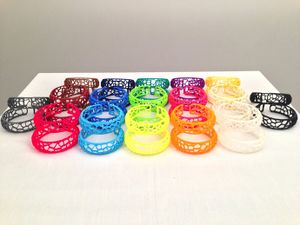
|
Introduction
My name is Dimitar. I am a super senior in Computer Science with a Math minor.
